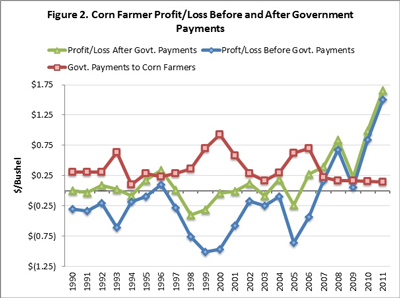Since ethanol production has grown under the Renewable Fuel Standard over the past six years, government farm program payments for corn growers have declined to their lowest levels in recent history, which is saving taxpayer dollars.
In a new E-xchange Blog post, Renewable Fuels Association VP for Research and Analysis Geoff Cooper shows how the RFS has helped boost corn prices above cost of production since 2007, which decreases program payments. Prior to 2007, going back to 1990, the market price for corn exceeded the cost of production only once (1996) between 1990 and 2006. In some years (e.g., 1993, 1998-2000, 2005), the cost of production was nearly $1 per bushel higher than the harvest price paid to the farmer.
Between 1990 and 2006, producing corn was a losing business proposition. In all but one of those 17 years, the average farmer’s cost of producing corn was higher than the returns earned from selling the corn. In other words, corn cost more to produce than it was worth. As a result, U.S. grain farmers became increasingly reliant on government payments as a source of income—and as a means of survival. Due in part to the emergence of the ethanol industry and the certainty provided by the RFS, this dynamic has changed.
Cooper notes that since passage of the Energy Independence and Security Act (EISA) and expansion of the RFS in 2007 corn prices have been above the cost of production, and government payments have fallen. “Though not reflected in the above figures (due to lack of 2012 cost of production data), government payments to corn farmers in 2012 are forecast to be their lowest in 18 years and less than one-quarter of 2006’s outlays,” Cooper writes. “As a consequence of the grain sector’s economic resurgence, Congress is now considering sweeping changes to the Farm Bill that would further reduce the program’s impact on taxpayers and the federal budget.”


